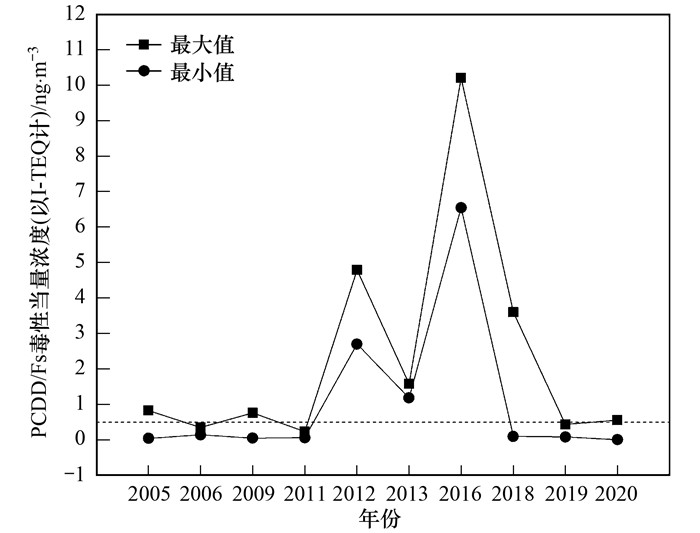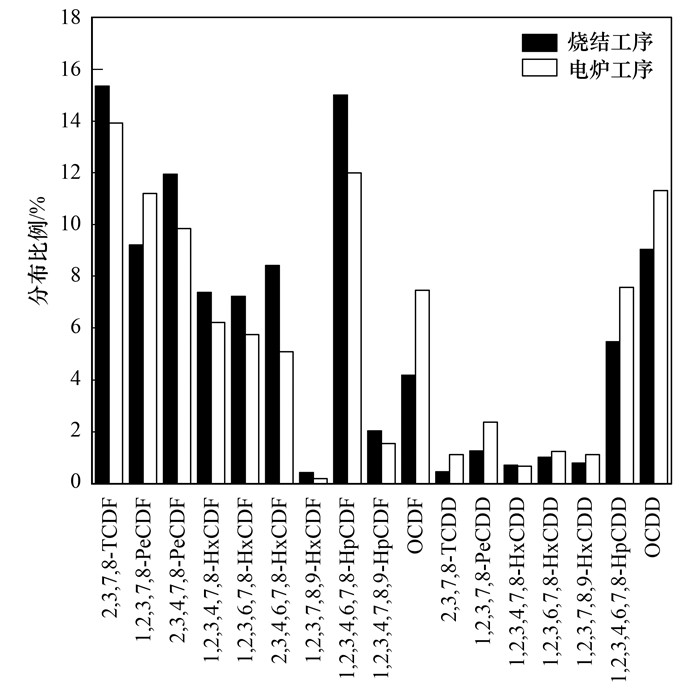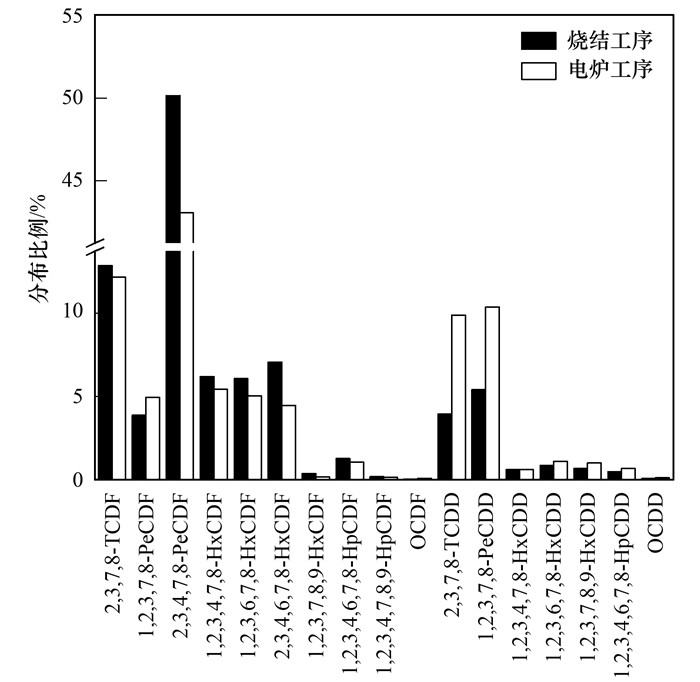 英污染特征变化及其排放因子
英污染特征变化及其排放因子
 英(PCDD/Fs)污染水平、排放特征及其排放因子进行了初步研究.结果表明, 烧结工序PCDD/Fs毒性当量浓度(以I-TEQ计, 下同)为0.003~0.557 ng·m-3, 均值为0.165 ng·m-3; 电炉工序PCDD/Fs毒性当量浓度为0.006~0.057 ng·m-3, 均值为0.025 ng·m-3.PCDD/Fs毒性当量浓度水平总体较低, 较2005~2019年研究报道结果下降1~2个数量级. 2005~2020年, 钢铁生产行业排放PCDD/Fs毒性当量浓度水平先升高后降低, 尤其是新的标准限值实施以及对烟尘等常规污染物进行超低排放控制后, 呈现大幅下降.指纹谱图特征显示, 所有烟气样品17种PCDD/Fs中最大浓度贡献单体为2, 3, 7, 8-TCDF, 与已有研究中以高氯代PCDFs和PCDDs为主不同, 且低氯代PCDFs占比有所增加, 表明PCDD/Fs生成主要来源有所变化.烧结工序和电炉工序PCDD/Fs同类物指纹分布特征相似, 呈现典型的高温热过程特征, 两个工序生产过程中PCDD/Fs的生成机制可能均为“从头合成”.钢铁生产企业烧结工序PCDD/Fs废气排放因子(以I-TEQ计, 下同)为0.003~0.5 μg·t-1, 排放因子平均值为(0.18±0.22)μg·t-1; 电炉工序PCDD/Fs废气排放因子为0.04~0.5 μg·t-1, 排放因子平均值为(0.27±0.23)μg·t-1; 低于UNEP于2013发布的“二
英(PCDD/Fs)污染水平、排放特征及其排放因子进行了初步研究.结果表明, 烧结工序PCDD/Fs毒性当量浓度(以I-TEQ计, 下同)为0.003~0.557 ng·m-3, 均值为0.165 ng·m-3; 电炉工序PCDD/Fs毒性当量浓度为0.006~0.057 ng·m-3, 均值为0.025 ng·m-3.PCDD/Fs毒性当量浓度水平总体较低, 较2005~2019年研究报道结果下降1~2个数量级. 2005~2020年, 钢铁生产行业排放PCDD/Fs毒性当量浓度水平先升高后降低, 尤其是新的标准限值实施以及对烟尘等常规污染物进行超低排放控制后, 呈现大幅下降.指纹谱图特征显示, 所有烟气样品17种PCDD/Fs中最大浓度贡献单体为2, 3, 7, 8-TCDF, 与已有研究中以高氯代PCDFs和PCDDs为主不同, 且低氯代PCDFs占比有所增加, 表明PCDD/Fs生成主要来源有所变化.烧结工序和电炉工序PCDD/Fs同类物指纹分布特征相似, 呈现典型的高温热过程特征, 两个工序生产过程中PCDD/Fs的生成机制可能均为“从头合成”.钢铁生产企业烧结工序PCDD/Fs废气排放因子(以I-TEQ计, 下同)为0.003~0.5 μg·t-1, 排放因子平均值为(0.18±0.22)μg·t-1; 电炉工序PCDD/Fs废气排放因子为0.04~0.5 μg·t-1, 排放因子平均值为(0.27±0.23)μg·t-1; 低于UNEP于2013发布的“二 英和呋喃排放识别和量化标准工具包”以及2004年我国二
英和呋喃排放识别和量化标准工具包”以及2004年我国二 英排放清单中的排放因子, 建议对我国钢铁生产行业PCDD/Fs排放状况开展调查, 更新排放因子.
英排放清单中的排放因子, 建议对我国钢铁生产行业PCDD/Fs排放状况开展调查, 更新排放因子.
 英
污染水平
排放特征
排放因子
英
污染水平
排放特征
排放因子
钢铁工业是我国国民经济的重要支柱产业, 是实现绿色低碳发展的重要领域[1].据中国钢铁协会统计, 2019年中国钢铁产量位居全球第一, 为9.96亿t, 占全球钢铁产量的53.31%, 2020年首次突破10亿t.随着产量的不断攀升[2], 钢铁生产行业的大气污染问题日益严重, 其主要生产过程如烧结(球团)和炼铁炼钢等排放的大气污染物种类繁多、成分复杂, 且排放量大, 主要包括二氧化硫、氮氧化物和二


二









本研究采集了7家钢铁企业8条生产线(包括4个铁矿石烧结炉和4个电炉)排放烟气样品, 采样时间集中于2020年9月.烟气样品采集参照HJ 77.2-2008[16], 采样仪器为烟气采样器(MEGA, APIS, 意大利), 分别用玻璃纤维滤筒、XAD-2树脂和棕色玻璃瓶收集颗粒相、气相和液相二
|
|
表 1 钢铁生产企业现场采样情况 Table 1 Sampling conditions of steel enterprises |
1.2 样品处理与仪器分析
将采集的烟气样品滤筒和树脂用甲苯连续抽提24 h, 冷凝水用二氯甲烷萃取3次后与抽提液合并浓缩后经多段层析柱净化[17], 洗脱液浓缩后转移至进样瓶中, 加入13C标记的进样内标, 待仪器分析.利用高分辨气相色谱-高分辨双聚焦磁质谱联用仪(Trace 1310 GC/DFS)分析, 载气流速为1.0 mL·min-1, 色谱柱为DB-5 (0.25 mm×0.25 μm×60 m), 进样量为1 μL, 不分流.色谱柱升温程序: 初始温度为90℃, 保持2 min, 然后以18 ℃·min-1的速率升至220℃, 再以1.4 ℃·min-1升至260℃, 最后4 ℃·min-1升至305℃, 保持4 min, 进样口温度为250℃.质谱条件: 电离能45 eV; 离子化电流900 μA; EI源温度280℃; 分辨率≥10 000.
1.3 质量保证与质量控制采用13C同位素内标稀释定量法对烟气样品中PCDD/Fs进行定量, 运输空白和操作空白检出结果均低于方法检出限, 所有样品的采样内标回收率在95%~126%, 提取内标回收率在44%~132%, 均符合质控要求.
1.4 排放因子计算PCDD/Fs废气排放因子采用下式计算:

|
(1) |
式中, EF废气为废气排放因子, 即生产1 t产品时通过废气排放PCDD/Fs的量(以I-TEQ计, μg·t-1); C为排放废气中PCDD/Fs的毒性当量浓度(以I-TEQ计, ng·m-3), V为标准状态下排放废气的流量(m3·h-1); I为设施的平均生产效率(t·h-1).
2 结果与讨论 2.1 钢铁生产行业PCDD/Fs排放水平本研究中7家钢铁企业8条生产线排放烟气中PCDD/Fs浓度分布如表 2所示, 所有烟气样品中PCDD/Fs浓度变化范围为0.035~4.90 ng·m-3, 均值为0.813 ng·m-3; PCDD/Fs毒性当量浓度(以I-TEQ计, 下同)变化范围为0.003~0.557 ng·m-3, 均值为0.095 ng·m-3.监测结果显示, 本研究中钢铁生产企业排放烟气中PCDD/Fs浓度水平总体较低, 且远低于我国现行标准限值(0.5 ng·m-3)[18, 19].其中烧结工序PCDD/Fs毒性当量浓度变化范围为0.003~0.557 ng·m-3, 均值为0.165 ng·m-3; 电炉工序PCDD/Fs毒性当量浓度变化范围为0.006~0.057 ng·m-3, 均值为0.025 ng·m-3, 烧结工序排放烟气中PCDD/Fs平均毒性当量浓度远高于电炉工序.在钢铁工业生产过程中, 长流程烧结工序是主要的PCDD/Fs产生来源, 但短流程电炉炼钢工序也会产生大量PCDD/Fs, 这是因为电炉冶炼过程中废钢预热温度和PCDD/Fs形成温度相近, 前驱体合成及热分解反应便促使了烟气中PCDD/Fs的形成, 同时废钢中微量铜、镍等氧化物可作为催化剂, 促进PCDD/Fs的生成.随着我国废钢资源的不断增加和实现碳达峰碳中和的目标, 未来加大电炉钢占比已成必然选择, 电炉炼钢排放PCDD/Fs问题也将不容忽视.值得注意的是, 钢铁企业B烧结工序PCDD/Fs排放浓度远高于其他3家钢铁企业烧结工序, 且超出了标准限值(0.5 ng·m-3), 进一步调查分析发现, 其排放尾气烟尘浓度相对较高, 而烟气中大部分二

|
|
表 2 烟气中二 |
2.2 钢铁生产行业PCDD/Fs污染特征变化 2.2.1 钢铁生产行业PCDD/Fs排放浓度变化趋势
由表 3可以看出, 本研究中烧结工序和电炉工序排放PCDD/Fs毒性当量浓度与已有研究报道相比, 均呈现出明显的降低趋势, 较2005~2019年下降1~2个数量级.
|
|
表 3 钢铁企业排放烟气中PCDD/Fs水平 Table 3 Emission level of dioxins in the flue gas of steel enterprises |
对表 3中钢铁生产企业排放PCDD/Fs毒性当量浓度变化趋势进行分析, 如图 1所示.可以看出, 2005~2020年, 钢铁生产行业排放PCDD/Fs毒性当量浓度水平总体呈现出先升高后降低的趋势, 可能是由于随着我国钢铁产量的不断增加, 排放PCDD/Fs毒性当量浓度随之增加, 但2012年我国钢铁工业系列排放标准[18, 19, 32, 33]发布实施后, 对PCDD/Fs减排起到了一定的积极作用, 导致排放PCDD/Fs毒性当量浓度水平开始呈现下降趋势; 同时随着科学技术的不断发展和环境监管的日趋加严, 企业运行管理水平和环保意识也在不断提升, 烟气PCDD/Fs净化处理系统及其工艺不断改善, 对排放烟气中PCDD/Fs起到了很好的控制作用.此外, 2016年国家大力推动钢铁行业落后产能企业淘汰, 从而进一步降低了行业排放PCDD/Fs毒性当量浓度水平.值得注意的是, 2019~2020年与以往相比, 呈现出较大的下降幅度, 推测其原因, 可能是文献[7]发布后, 通过对烟尘等常规污染物的严格控制, 大大促进了PCDD/Fs的协同减排, 但由于钢铁生产行业烟气排放量大, 且钢铁产量一直在不断增加, PCDD/Fs污染排放问题仍需关注.

|
虚线对应数值为0.5 ng·m-3(以I-TEQ计), 表示我国钢铁生产行业排放PCDD/Fs现行标准限值 图 1 钢铁生产行业2005~2020年排放PCDD/Fs毒性当量浓度水平变化趋势 Fig. 1 Trend of PCDD/Fs emission concentrations in iron and steel industry from 2005 to 2020 |
采集的钢铁生产企业烧结工序和电炉工序排放烟气样品中17种PCDD/Fs单体浓度分布如图 2所示.可以看出, 所有烟气样品中PCDD/Fs单体浓度分布特征均表现为PCDFs浓度显著高于PCDDs.烧结工序和电炉工序17种氯代异构体中PCDFs分别占总PCDD/Fs的质量分数为81.2%和73.3%, 表明钢铁生产行业烧结工序和电炉工序烟气中PCDD/Fs均以PCDFs为主, 呈现出典型的高温热过程特征, 与国内外学者调查结果相似[31, 34~36].烧结工序排放烟气中PCDD/Fs浓度主要贡献单体为2, 3, 7, 8-TCDF(15.3%)、1, 2, 3, 4, 6, 7, 8-HpCDF(15.0%)、2, 3, 4, 7, 8-PeCDF (11.9%)和1, 2, 3, 7, 8-PeCDF(9.22%), 与王凤炜等[22]报道的以2, 3, 7, 8-TCDF、1, 2, 3, 4, 6, 7, 8-HpCDF、2, 3, 4, 7, 8-PeCDF和OCDF为主不同, 与尹文华等[37]和Chiu等[38]报道的以1, 2, 3, 4, 6, 7, 8-HpCDF和1, 2, 3, 4, 6, 7, 8-HpCDD等高氯代单体为主也不同, 与巩宏平等[36]报道的以1, 2, 3, 4, 6, 7, 8-HpCDF、2, 3, 7, 8-TCDF和2, 3, 4, 7, 8-PeCDF为主相似, 但不同的是本研究最大贡献单体为2, 3, 7, 8-TCDF.电炉工序排放烟气中PCDD/Fs浓度主要贡献单体为2, 3, 7, 8-TCDF(13.9%)、1, 2, 3, 4, 6, 7, 8-HpCDF(12.0%)、OCDD(11.3%)和1, 2, 3, 7, 8-PeCDF(11.2%), 与邹川[26]和陆勇等[28]报道的电炉炼钢排放烟气中PCDD/Fs以1, 2, 3, 4, 6, 7, 8-HpCDD/F和OCDD等高氯代单体不同.有报道指出[39], 电弧炉炼钢在废料预热阶段以高氯代单体为主, 在冶炼阶段以低氯代单体为主, 这表明本研究电炉工序中生成PCDD/Fs的阶段主要为冶炼阶段.烧结工序和电炉工序排放烟气样品中17种PCDD/Fs单体浓度分布特征总体一致, 随着氯取代数的增加, PCDFs同类物浓度呈先降低后增加趋势, PCDDs同类物浓度呈增加趋势; 不同的是OCDD在电炉工序中的浓度贡献率相对烧结工序较高.有研究显示[40], 低氧气氛下更促进PCDDs的增长, 尤其是TCDD, 富氧气氛下更促进PCDFs的增长, 以TCDF为主; 而本研究中烟气含氧量相对较高(17%~21%), 促进了低氯代PCDFs的生成.

|
图 2 烟气中17种PCDD/Fs单体浓度分布比例 Fig. 2 Content distribution of PCDD/Fs congeners in flue gas |
如图 3所示, 所有烟气样品中PCDD/Fs单体毒性当量浓度分布特征表现为PCDFs的TEQ值显著高于PCDDs, 烧结工序和电炉工序排放烟气中PCDFs分别占PCDD/Fs毒性当量浓度的88.1%和76.5%.烧结工序排放烟气中PCDD/Fs主要毒性贡献单体为2, 3, 4, 7, 8-PeCDF(50.1%)、2, 3, 7, 8-TCDF(12.9%)和2, 3, 4, 6, 7, 8-HxCDF(7.07%), 电炉工序排放烟气中PCDD/Fs主要毒性贡献单体为2, 3, 4, 7, 8-PeCDF(43.1%)、2, 3, 7, 8-TCDF(12.2%)和1, 2, 3, 7, 8-PeCDD(10.4%).两个工序排放烟气中PCDD/Fs最大毒性贡献单体均为2, 3, 4, 7, 8-PeCDF, 其次是2, 3, 7, 8-TCDF, 与典型的铁矿石烧结和电炉炼钢过程中PCDD/Fs同类物毒性当量浓度分布特征相似[29, 41].

|
图 3 烟气中17种PCDD/Fs单体毒性当量浓度分布比例 Fig. 3 Content distribution of PCDD/Fs congeners (I-TEQ) in flue gas |
总体来看, 本研究中钢铁生产企业排放烟气中PCDFs浓度显著高于PCDDs, 且PCDFs随着Cl原子取代数目的增加, 同系物浓度呈下降趋势, 而PCDDs则相反; 烧结工序和电炉工序PCDD/Fs同类物指纹分布特征相似, 均呈现出以PCDFs占主导, 表明烧结工序和电炉工序生产过程中PCDD/Fs的生成机制相似, 可能均为“从头合成”[42].与已有研究报道相比, 本研究钢铁生产企业PCDD/Fs同类物分布特征呈现出比较明显的变化, 即低氯代PCDFs占比有明显增加趋势, 且最大浓度贡献单体为2, 3, 7, 8-TCDF, 不同于已有研究中以高氯代PCDFs为主, 且最大浓度贡献单位为1, 2, 3, 4, 6, 7, 8-HpCDF, 表明PCDD/Fs生成主要来源有所不同; PCDD/Fs异构体毒性当量浓度分布特征未出现较大变化.
2.3 钢铁生产行业PCDD/Fs排放因子根据采集的7家钢铁生产企业烧结工序和电炉工序排放烟气PCDD/Fs毒性当量浓度、年生产量和工况等数据, 对烧结工序和电炉工序PCDD/Fs废气排放因子进行了计算, 结果如表 4所示.烧结工序PCDD/Fs废气排放因子(以I-TEQ计, 下同)在0.003~0.5 μg·t-1范围之间, 排放因子平均值为(0.18±0.22)μg·t-1; 其中烧结机规模180 m2以下的废气PCDD/Fs排放因子为0.05~0.2 μg·t-1, 180 m2以上的废气排放因子为0.003~0.5 μg·t-1.电炉工序PCDD/Fs废气排放因子为0.04~0.5 μg·t-1, 排放因子平均值为(0.27±0.23)μg·t-1; 其中, 30 t以下炼钢炉PCDD/Fs废气排放因子为0.1 μg·t-1, 30~50 t (含)炼钢炉PCDD/Fs废气排放因子为0.4~0.5 μg·t-1, 50 t以上炼钢炉PCDD/Fs废气排放因子为0.04 μg·t-1.数据显示, 除钢铁企业B烧结工序废气排放因子略高于联合国环境规划署(UNEP)[43]于2013年发布的铁矿石烧结第3级排放因子0.3 μg·t-1, 其他企业烧结工序废气PCDD/Fs排放因子均显著低于而UNEP铁矿石烧结第3级排放因子和2004年我国PCDD/Fs排放清单中烧结工序大气排放因子(5 μg·t-1)[13].与国内其它铁矿石烧结废气PCDD/Fs排放因子研究相比[25, 44], 相对较低, 但高于河北某钢铁厂烧结废气PCDD/Fs排放因子[45].此外, 钢铁企业C和钢铁企业D烧结规模及烟气处理工艺均相同, 但废气排放因子差别较大, 分析其原因可能是由于二者烧结燃料、回用废料比例、工况控制及生产效率等相差较大所致.所有企业电炉工序废气排放因子均远低于UNEP电弧炉第2级排放因子(3 μg·t-1), 其中钢铁企业E和钢铁企业F电炉工序废气PCDD/Fs排放因子高于赵羚杰[44]的调查结果.综上来看,
|
|
表 4 钢铁生产行业排放废气PCDD/Fs排放因子 Table 4 Emission factors of PCDD/Fs in flue gas at steel industries |
本研究中钢铁生产企业烧结工序和电炉工序废气PCDD/Fs排放因子处于较低水平, 说明我国钢铁生产行业PCDD/Fs排放因子有待更新, 建立最新的钢铁生产行业PCDD/Fs排放清单具有一定的迫切性.
3 结论(1) 7家钢铁生产企业烧结工序和电炉工序排放烟气中PCDD/Fs毒性当量浓度变化范围为0.003~0.557 ng·m-3, 均值为0.095 ng·m-3.其中烧结工序PCDD/Fs毒性当量浓度变化范围为0.003~0.557 ng·m-3, 均值为0.165 ng·m-3; 电炉工序PCDD/Fs毒性当量浓度变化范围为0.006~0.057 ng·m-3, 均值为0.025 ng·m-3.本研究中钢铁生产企业排放PCDD/Fs毒性当量浓度水平较低, 与已有研究报道相比, 呈现出明显的降低趋势, 较2005~2019年降低1~2个数量级, 且2019~2020年呈现大幅下降趋势, 但钢铁生产行业烟气排放量大, PCDD/Fs污染排放问题仍需关注.
(2) 总体来看, 与已有研究相比, 所有烟气样品中PCDD/Fs同类物分布特征呈现出比较明显的变化, 即最大浓度贡献单体为2, 3, 7, 8-TCDF, 不同于以往研究中以高氯代PCDFs为主, 且低氯代PCDFs占比有所增加, 表明PCDD/Fs生成主要来源有所不同.对比4个烧结炉和4个电炉烟气中17种PCDD/Fs单体浓度分布, 发现烧结工序和电炉工序PCDD/Fs同类物指纹分布特征相似, 均以PCDFs占主导, 呈现典型的高温热过程特征, 且PCDFs随着Cl原子取代数目的增加, 同系物浓度呈下降趋势, PCDFs以TCDF、PeCDFs和HxCDFs为主, 两个工序生产过程中PCDD/Fs的生成机制可能均为“从头合成”.
(3) 基于实测数据获取了钢铁生产行业烧结工序PCDD/Fs废气排放因子为0.003~0.5 μg·t-1, 排放因子平均值为(0.18±0.22) μg·t-1; 其中烧结机规模180 m2以下的废气PCDD/Fs排放因子为0.05~0.2 μg·t-1, 180 m2以上的废气排放因子为0.003~0.5 μg·t-1.电炉工序PCDD/Fs废气排放因子为0.04~0.5 μg·t-1, 排放因子平均值为(0.27±0.23) μg·t-1; 其中, 30 t以下炼钢炉PCDD/Fs废气排放因子为0.1 μg·t-1, 30~50 t (含)炼钢炉PCDD/Fs废气排放因子为0.4~0.5 μg·t-1, 50 t以上炼钢炉PCDD/Fs废气排放因子为0.04 μg·t-1, 排放因子水平较低.
| [1] | 工业和信息化部. 关于推动钢铁工业高质量发展的指导意见(征求意见稿)[EB/OL]. https://www.miit.gov.cn/jgsj/ycls/gzdt/art/2020/art_8fc2875eb24744f591bfd946c126561f.html, 2020-12-31. |
| [2] | Word Steel Association (WSA). Steel Statistical Yearbook 1990-2019 (Word Steel Association, 1990-2019)[EB/OL]. https://www.worldsteel.org/media-centre/press-releases/2019/2019-Steel-Statistical-Yearbook-published.html, 2019-12-05. |
| [3] |
汤铃, 薛晓达, 伯鑫, 等. 中国钢铁行业大气环境影响[J]. 环境科学, 2020, 41(7): 2981-2994. Tang L, Xue X D, Bo X, et al. Contribution of emissions from the iron and steel industry to air quality in China[J]. Environmental Science, 2020, 41(7): 2981-2994. |
| [4] |
温杰, 杨佳美, 李蒲, 等. 我国典型钢铁行业主要工艺环节排放颗粒物源成分谱特征[J]. 环境科学, 2018, 39(11): 4885-4891. Wen J, Yang J M, Li P, et al. Chemical source profiles of PM emitted from the main processes of the iron and steel industry in China[J]. Environmental Science, 2018, 39(11): 4885-4891. |
| [5] |
汤铃, 贾敏, 伯鑫, 等. 中国钢铁行业排放清单及大气环境影响研究[J]. 中国环境科学, 2020, 40(4): 1493-1506. Tang L, Jia M, Bo X, et al. High resolution emission inventory and atmospheric environmental impact research in Chinese iron and steel industry[J]. China Environmental Science, 2020, 40(4): 1493-1506. DOI:10.3969/j.issn.1000-6923.2020.04.014 |
| [6] |
刘飞, 薛志钢, 续鹏, 等. 钢铁行业典型烧结机污染物排放特征对比研究[J]. 环境科学研究, 2020, 33(4): 849-858. Liu F, Xue Z G, Xu P, et al. Comparative study on pollutant emission characteristics of typical sintering machines in iron and steel industry[J]. Research of Environmental Science, 2020, 33(4): 849-858. |
| [7] | 生态环境部, 国家发展和改革委员会, 工业和信息化部, 等. 关于推进实施钢铁行业超低排放的意见[EB/OL]. http://www.mee.gov.cn/xxgk2018/xxgk/xxgk03/201904/t20190429_701463.html, 2019-04-28. |
| [8] | Schecter A, Birnbaum L, Ryan J J, et al. Dioxins: an overview[J]. Environmental Research, 2006, 101(3): 419-428. DOI:10.1016/j.envres.2005.12.003 |
| [9] | Bannasch P, Becher H, Bertazz P A, et al. Polychlorinated dibenzo-para-dioxins and polychlorinated dibenzofurans[M]. Lyon, France: International Agency for Research on Cancer (IARC), 1997. |
| [10] |
黄文, 张素坤, 杜国勇, 等. 医疗废物焚烧炉周边环境介质中二 英的浓度、同系物分布与来源分析[J]. 环境科学, 2013, 34(8): 3238-3243. 英的浓度、同系物分布与来源分析[J]. 环境科学, 2013, 34(8): 3238-3243.Huang W, Zhang S K, Du G Y, et al. Concentration, profile distribution and source identification of PCDD/Fs in environmental medium around a HSWI[J]. Environmental Science, 2013, 34(8): 3238-3243. |
| [11] | Yang Q T, Yang L L, Shen J, et al. Polychlorinated dibenzo-p-dioxins and dibenzofurans (PCDD/Fs) emissions from electric Arc furnaces for steelmaking[J]. Emerging Contaminants, 2020, 6: 330-336. DOI:10.1016/j.emcon.2020.08.005 |
| [12] | Zhou T, Bo X, Qu J B, et al. Characteristics of PCDD/Fs and metals in surface soil around an iron and steel plant in North China Plain[J]. Chemosphere, 2019, 216: 413-418. DOI:10.1016/j.chemosphere.2018.10.024 |
| [13] |
郑明辉, 孙阳昭, 刘文彬. 中国二 英类持久性有机污染物排放清单研究[M]. 北京: 中国环境科学出版社, 2008. 英类持久性有机污染物排放清单研究[M]. 北京: 中国环境科学出版社, 2008.
|
| [14] | 张苏, 董慧芹, 王文利. 钢铁行业二恶英减排技术分析[J]. 能源与环境, 2015(6): 70-71, 73. DOI:10.3969/j.issn.1672-9064.2015.06.030 |
| [15] |
徐帅玺, 林晓青, 陈彤, 等. 钢铁行业不同物料的二 英生成分布及机理探讨[J]. 环境科学学报, 2018, 38(7): 2818-2824. 英生成分布及机理探讨[J]. 环境科学学报, 2018, 38(7): 2818-2824.Xu S X, Lin X Q, Chen T, et al. PCDD/F formation and distribution of various materials from steel industry[J]. Acta Scientiae Circumstantiae, 2018, 38(7): 2818-2824. |
| [16] |
HJ 77.2-2008, 环境空气和废气二 英类的测定同位素稀释高分辨气相色谱-高分辨质谱法[S]. 英类的测定同位素稀释高分辨气相色谱-高分辨质谱法[S]. HJ 77.2-2008, Ambient air and waste gas determination of polychlorinated dibenzo-p-dioxins (PCDDs) and polychlorinated dibenzofurans (PCDFs)[S]. |
| [17] | 张素坤, 宁慧平, 任明忠, 等. 一段法纯化环境基质萃取液中二恶英类物质的方法及装置[P]. 中国专利: CN 102539548A, 2012-07-04. |
| [18] |
GB 28662-2012, 钢铁烧结、球团工业大气污染物排放标准[S]. GB 28662-2012, Emission standard of air pollutants for sintering and pelletizing of iron and steel industry[S]. |
| [19] |
GB 28664-2012, 炼钢工业大气污染物排放标准[S]. GB 28664-2012, Emission standard of air pollutants for steel smelt industry[S]. |
| [20] |
苍大强, 魏汝飞, 张玲玲, 等. 钢铁工业烧结过程二 英的产生机理与减排研究进展[J]. 钢铁, 2014, 49(8): 1-8. 英的产生机理与减排研究进展[J]. 钢铁, 2014, 49(8): 1-8.Cang D Q, Wei R F, Zhang L L, et al. Formation mechanism and emission reduction of PCDD/Fs in iron ore sintering[J]. Iron and Steel, 2014, 49(8): 1-8. DOI:10.3969/j.issn.1006-6764.2014.08.001 |
| [21] |
田梦, 曹彦涛, 宋进轩. 烧结及炼钢生产过程二 英类污染物控制技术及排放现状[J]. 宽厚板, 2020, 26(4): 31-33. 英类污染物控制技术及排放现状[J]. 宽厚板, 2020, 26(4): 31-33.Tian M, Cao Y T, Song J X. Control technology and emission status of dioxin-like pollutants in sintering and steelmaking[J]. Wide and Heavy Plate, 2020, 26(4): 31-33. DOI:10.3969/j.issn.1009-7864.2020.04.010 |
| [22] |
王凤炜, 付建英, 林晓青, 等. 钢铁冶炼行业二 英排放特性和厂区内大气中二 英排放特性和厂区内大气中二 英分布规律[J]. 环境科学学报, 2018, 38(4): 1404-1409. 英分布规律[J]. 环境科学学报, 2018, 38(4): 1404-1409.Wang F W, Fu J Y, Lin X Q, et al. The emission characteristics of dioxins from steel industry and distribution of dioxins in the atmosphere of plant[J]. Acta Scientiae Circumstantiae, 2018, 38(4): 1404-1409. |
| [23] |
白昭, 王瑶, 马文鹏. 烧结炼铁过程中二 英排放浓度及同类物分布研究[J]. 广东化工, 2016, 43(2): 57-58. 英排放浓度及同类物分布研究[J]. 广东化工, 2016, 43(2): 57-58.Bai Z, Wang Y, Ma W P. The concentration and distribution research on the congeners of dioxins during the sintering process of steel industry[J]. Guangdong Chemical Industry, 2016, 43(2): 57-58. DOI:10.3969/j.issn.1007-1865.2016.02.026 |
| [24] |
杨艳艳, 韩静磊, 青宪, 等. 珠江三角洲典型行业排放废气中PCDD/Fs污染水平[J]. 中国环境科学, 2013, 33(S1): 186-190. Yang Y Y, Han J L, Qing X, et al. PCDD/Fs pollutions in exhaust gases from typical industries of the Pearl River Delta[J]. China Environmental Science, 2013, 33(S1): 186-190. |
| [25] | Tian B, Huang J, Wang B, et al. Emission characterization of unintentionally produced persistent organic pollutants from iron ore sintering process in China[J]. Chemosphere, 2012, 89(4): 409-415. DOI:10.1016/j.chemosphere.2012.05.069 |
| [26] |
邹川. 典型行业PCDD/Fs排放特征及其控制研究[D]. 广州: 华南理工大学, 2012. Zou C. Study on emission characteristics and control of PCDD/Fs from typical industries[D]. Guangzhou: South China University of Technology, 2012. |
| [27] | Lv P, Zheng M H, Liu G R, et al. Estimation and characterization of PCDD/Fs and dioxin-like PCBs from Chinese iron foundries[J]. Chemosphere, 2011, 82(5): 759-763. DOI:10.1016/j.chemosphere.2010.10.077 |
| [28] |
陆勇, 田洪海, 周志广, 等. 电弧炉炼钢过程中二 英类的排放浓度和同类物分布[J]. 环境科学研究, 2009, 22(3): 304-308. 英类的排放浓度和同类物分布[J]. 环境科学研究, 2009, 22(3): 304-308.Lu Y, Tian H H, Zhou Z G, et al. Concentrations and congener profiles of dioxins in stack gas and fly ash samples from an electric arc furnace[J]. Research of Environmental Sciences, 2009, 22(3): 304-308. |
| [29] | Wang J B, Hung C H, Hung C H, et al. Polychlorinated dibenzo-p-dioxin and dibenzofuran emissions from an industrial park clustered with metallurgical industries[J]. Journal of Hazardous Materials, 2009, 161(2-3): 800-807. DOI:10.1016/j.jhazmat.2008.04.026 |
| [30] | Chang M B, Huang H C, Tsai S S, et al. Evaluation of the emission characteristics of PCDD/Fs from electric arc furnaces[J]. Chemosphere, 2006, 62(11): 1761-1773. DOI:10.1016/j.chemosphere.2005.07.054 |
| [31] | Lee W S, Chang-Chien G P, Wang L C, et al. Emissions of polychlorinated dibenzo-p-dioxins and dibenzofurans from stack gases of electric arc furnaces and secondary aluminum smelters[J]. Journal of the Air & Waste Management Association, 2005, 55(2): 219-226. |
| [32] |
GB 28663-2012, 炼铁工业大气污染物排放标准[S]. GB 28663-2012, Emission standard of air pollutants for iron smelt industry[S]. |
| [33] |
GB 28665-2012, 轧钢工业大气污染物排放标准[S]. GB 28665-2012, Emission standard of air pollutants for steel rolling industry[S]. |
| [34] | Anderson D R, Fisher R. Sources of dioxins in the United Kingdom: the steel industry and other sources[J]. Chemosphere, 2002, 46(3): 371-381. DOI:10.1016/S0045-6535(01)00178-3 |
| [35] |
谢馨. 南京市钢铁行业烧结机二 英排放调查研究[J]. 环境科学与管理, 2014, 39(8): 130-133. 英排放调查研究[J]. 环境科学与管理, 2014, 39(8): 130-133.Xie X. Investigation on dioxin emission from sintering machines-a case study in iron and steel industry of Nanjing[J]. Environmental Science and Management, 2014, 39(8): 130-133. |
| [36] |
巩宏平, 田洪海, 周志广, 等. 钢铁企业排放的烟气及厂区土壤中二 英类污染研究[J]. 环境保护科学, 2007, 33(5): 8-10. 英类污染研究[J]. 环境保护科学, 2007, 33(5): 8-10.Gong H P, Tian H H, Zhou Z G, et al. Preliminary study on the dioxin polluants in site soil and flue gas emitted by iron and steel in plant[J]. Environmental Protection Science, 2007, 33(5): 8-10. DOI:10.3969/j.issn.1004-6216.2007.05.003 |
| [37] |
尹文华, 彭江波, 龙世康, 等. 烧结和球团PCDD/Fs的污染特征与健康风险评价[J]. 烧结球团, 2021, 46(1): 1-7. Yin W H, Peng J B, Long S K, et al. Pollution characteristics and health risk assessment of PCDD/Fs of sintering and pelletizing[J]. Sintering and Pelletizing, 2021, 46(1): 1-7. |
| [38] | Chiu J C, Shen Y H, Li H W, et al. Emissions of polychlorinated dibenzo-p-dioxins and dibenzofurans from an electric arc furnace, secondary aluminum smelter, crematory and joss paper incinerators[J]. Aerosol and Air Quality Research, 2011, 11(1): 13-20. DOI:10.4209/aaqr.2010.06.0051 |
| [39] |
杨秋婷. 电弧炉炼钢过程中氯代和溴代二恶英的排放特征研究[D]. 北京: 钢铁研究总院, 2021. Yang Q T. Study on emission profile of PCDD/Fs and PBDD/Fs in the electric arc furnace steelmaking process[D]. Beijing: Central Iron & Steel Research Institute, 2021. |
| [40] |
王天娇. 生活垃圾焚烧过程中二 英及其关联物氯苯的特性研究[D]. 杭州: 浙江大学, 2018. 英及其关联物氯苯的特性研究[D]. 杭州: 浙江大学, 2018. Wang T J. Characteristics of PCDD/Fs related to chlorobenzenes in municipal solid waste incineration[D]. Hangzhou: Zhejiang University, 2018. |
| [41] |
王梦京, 吴素愫, 高新华, 等. 铁矿石烧结行业二 英类形成机制与排放水平[J]. 环境化学, 2014, 33(10): 1723-1732. 英类形成机制与排放水平[J]. 环境化学, 2014, 33(10): 1723-1732.Wang M J, Wu S S, Gao X H, et al. Formation mechanism and emission profiles of PCDD/Fs in iron ore sintering[J]. Environmental Chemistry, 2014, 33(10): 1723-1732. DOI:10.7524/j.issn.0254-6108.2014.10.014 |
| [42] | Huang H, Buekens A. On the mechanisms of dioxin formation in combustion processes[J]. Chemosphere, 1995, 31(9): 4099-4117. DOI:10.1016/0045-6535(95)80011-9 |
| [43] | United Nations Environment Programme (UNEP). Toolkit for identification and quantification of releases of dioxins, furans and other unintentional POPs[EB/OL]. http://toolkit.pops.int/Publish/Downloads/UNEP-POPS-TOOLKIT-2012-En.pdf, 2013-01-18. |
| [44] |
赵羚杰. 中国钢铁行业大气污染物排放清单及减排成本研究[D]. 杭州: 浙江大学, 2016. Zhao L J. Study on air pollutant emissions of iron and steel plants in China and the cost of emission reduction[D]. Hangzhou: Zhejiang University, 2016. |
| [45] |
孙博飞, 伯鑫, 张尚宣, 等. 钢厂烧结机烟气排放对土壤二 英浓度的影响[J]. 中国环境科学, 2017, 37(11): 4222-4229. 英浓度的影响[J]. 中国环境科学, 2017, 37(11): 4222-4229.Sun B F, Bo X, Zhang S X, et al. Effect of exhaust gas from sintering machines on the concentration of dioxin in soil around a steel plant[J]. China Environmental Science, 2017, 37(11): 4222-4229. DOI:10.3969/j.issn.1000-6923.2017.11.027 |
 2022, Vol. 43
2022, Vol. 43



 英等有机污染物监测, E-mail:
英等有机污染物监测, E-mail: